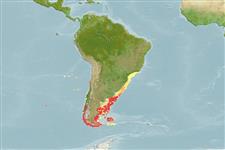Ελασμοβράγχιοι (καρχαρίες και σαλάχια) (sharks and rays) >
Carcharhiniformes (Ground sharks) >
Atelomycteridae (Coloured catsharks)
Etymology: Schroederichthys: In honor of American ichthyologist William C. Schroeder (1895-1977), Woods Hole Oceanographic Institution, for his pioneering work (with Henry B. Bigelow) on cartilaginous fishes; ichthyos (Gr.), fish (See ETYFish); bivius: bi-, from bis (L.), two; via (L.), way or passage, etymology not explained, perhaps referring to double-valved nostrils, with incurrent and excurrent apertures (See ETYFish).
Eponymy: William Charles Schroeder (1894–1977) was an American oceanographer and ichthyologist. [...] (Ref. 128868), visit book page.
More on authors: Müller & Henle.
Environment: milieu / climate zone / depth range / distribution range
Οικολογία
Θαλασσινό(ά) βενθικό(ς); εύρος βάθους 14 - 78 m (Ref. 244). Subtropical; 23°S - 56°S
Southeast Pacific and Southwest Atlantic: central Chile to the Straits of Magellan and Argentina.
Length at first maturity / Μέγεθος / Βάρος / Age
Maturity: Lm ?, range 40 - ? cm
Max length : 70.0 cm TL αρσενικό/απροσδιόριστο; (Ref. 244)
A common inshore to offshore shark found on the continental shelf. Oviparous (Ref. 50449). Dental sexual dimorphism exists, with adult males having teeth at least twice as high as adult females as well as much longer and narrower mouths.
Oviparous, paired eggs are laid. Embryos feed solely on yolk (Ref. 50449). Sexual dimorphism is evident in dentition of male species (Ref. 49562). Males have longer teeth with fewer cusps than females (Ref. 51093) to make 'courtship biting' more effective (Ref. 49562).
Compagno, L.J.V., 1984. FAO Species Catalogue. Vol. 4. Sharks of the world. An annotated and illustrated catalogue of shark species known to date. Part 2 - Carcharhiniformes. FAO Fish. Synop. 125(4/2):251-655. Rome: FAO. (Ref. 244)
IUCN Red List Status (Ref. 130435: Version 2024-2)
Threat to humans
Harmless
Human uses
αλιεία: χωρίς ενδιαφέρον
Εργαλεία
Special reports
Download XML
Διαδικτυακές πηγές
Estimates based on models
Preferred temperature (Ref.
123201): 6.4 - 15.6, mean 10.6 °C (based on 202 cells).
Phylogenetic diversity index (Ref.
82804): PD
50 = 0.5312 [Uniqueness, from 0.5 = low to 2.0 = high].
Bayesian length-weight: a=0.00389 (0.00180 - 0.00842), b=3.12 (2.94 - 3.30), in cm total length, based on all LWR estimates for this body shape (Ref.
93245).
Τροφικό Επίπεδο (Ref.
69278): 3.8 ±0.3 se; based on diet studies.
Ελαστικότητα (Ref.
120179): Πολύ χαμηλό, ελάχιστος χρόνος για διπλασιασμό πληθυσμού > 14 έτη (Fec=2).
Fishing Vulnerability (Ref.
59153): Moderate to high vulnerability (48 of 100).
Nutrients (Ref.
124155): Calcium = 27.1 [4.5, 147.7] mg/100g; Iron = 0.723 [0.192, 2.131] mg/100g; Protein = 16.1 [13.3, 20.4] %; Omega3 = 0.18 [0.08, 0.39] g/100g; Selenium = 19.3 [5.8, 54.7] μg/100g; VitaminA = 10.6 [3.7, 29.9] μg/100g; Zinc = 0.636 [0.303, 1.164] mg/100g (wet weight); based on
nutrient studies.
